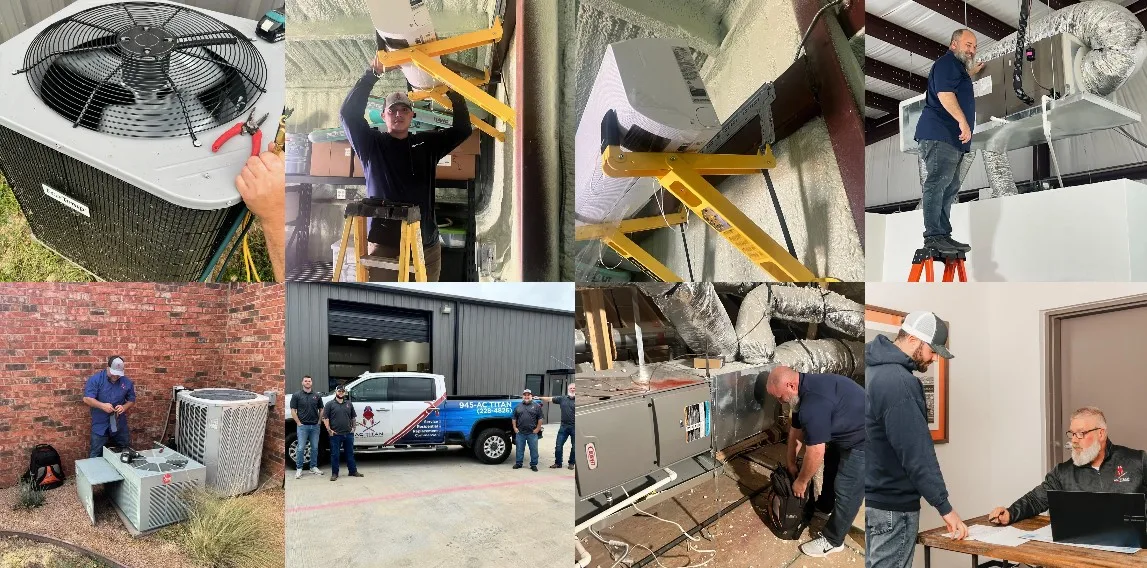The True Cost of Delaying HVAC Repairs: A Homeowner’s Financial Wake-Up Call
Every homeowner has experienced that moment of hesitation when an HVAC technician delivers an unexpected repair estimate. The temptation to postpone non-emergency fixes, hoping the system continues functioning a bit longer, feels financially prudent in the moment. However, this common decision-making error costs homeowners thousands of dollars through accelerated system deterioration, cascading component failures, and dramatically increased energy consumption. Understanding the hidden financial consequences of delayed repairs transforms how you approach HVAC maintenance and minor problems, ultimately protecting your home comfort investment while reducing long-term costs.
The Cascade Effect: How Small Problems Become Expensive Disasters
HVAC systems operate as integrated machines where individual components depend on others functioning correctly. When one component operates outside specifications, it places stress on related parts, creating a domino effect that multiplies repair costs. A simple example illustrates this principle: a failing capacitor struggling to start your compressor causes the compressor motor to work harder during every startup cycle. Over weeks and months, this excessive electrical stress degrades compressor windings, eventually causing complete compressor failure.
The financial difference is staggering. Replacing a worn capacitor during routine maintenance or when first showing symptoms costs $150-$250. Waiting until it fails completely and damages the compressor transforms a $200 repair into a $2,000-$2,500 compressor replacement—or potentially complete system replacement if the compressor fails in an older system. This ten-fold cost multiplication occurs not through bad luck but through predictable mechanical relationships between system components.
Professional HVAC services understand these cascade patterns, which is why quality contractors emphasize addressing minor issues promptly. They’ve witnessed countless situations where homeowners delayed $300 repairs that evolved into $2,000-$5,000 emergencies within months. The parts of an HVAC system work together—neglecting one component inevitably affects others.
Energy Waste: The Silent Drain on Your Budget
Beyond component damage, malfunctioning systems consume substantially more energy achieving the same comfort levels. This energy waste operates invisibly—you don’t receive itemized bills showing how much extra you’re paying because your evaporator coil needs cleaning or your refrigerant charge runs low. Yet these inefficiencies cost real money every single month.
Consider common scenarios and their energy impacts:
Dirty condenser coils reduce heat transfer efficiency by 20-30%, forcing your system to run longer achieving desired temperatures. For a household spending $200 monthly on cooling during summer months, this inefficiency adds $40-$60 monthly—$240-$360 over a six-month cooling season. Professional coil cleaning costs $150-$250, recovering its cost in energy savings within one summer.
Low refrigerant charge from small leaks increases energy consumption by 10-20% while reducing cooling capacity. Your system runs continuously during hot weather, never quite reaching comfortable temperatures while consuming maximum electricity. A $400 leak repair and refrigerant recharge prevents $300-$600 in wasted energy annually.
Restricted airflow from clogged filters or dirty blower wheels forces systems to work harder moving adequate air. This increases both heating and cooling costs by 15-25%. While homeowners can replace filters themselves, dirty blower assemblies require professional cleaning—typically $150-$200 during maintenance visits. This modest investment prevents $400-$700 in annual energy waste.
When you calculate energy waste over multiple months or years, delayed repairs cost far more than the repairs themselves. A $500 repair preventing $400 in annual energy waste pays for itself in 15 months, then continues delivering savings for the system’s remaining life.
The Inconvenience Factor: What’s Your Time Worth?
Financial analysis often overlooks the inconvenience value of reliable HVAC operation. Complete system failures don’t schedule themselves during convenient times—they occur during the hottest summer days or coldest winter nights when your system faces maximum demand. The cascading consequences of delayed repairs frequently manifest as emergency breakdowns during these peak periods.
Emergency service calls cost 1.5-2× normal rates due to after-hours labor, weekend premiums, and limited contractor availability. That $400 repair you delayed becomes a $700-$900 emergency service call. Worse, you experience hours or days without heating or cooling while awaiting service during periods when every contractor faces overwhelming demand.
Consider the broader disruption: elderly family members or young children suffering in extreme temperatures, work-from-home disruptions, spoiled food from extended outages, temporary relocation costs to hotels, and the stress of managing crisis situations. While difficult to quantify precisely, these inconveniences carry real costs and quality-of-life impacts that planned repairs avoid.
Professional heating and cooling maintenance operates on your schedule, at standard rates, with time to compare quotes and verify contractor credentials. Emergency situations eliminate these advantages, forcing immediate decisions under pressure—conditions that rarely produce optimal outcomes.
Warranty Voidance: Losing Valuable Protection
Most HVAC equipment includes manufacturer warranties covering parts for 5-10 years, with extended compressor warranties often reaching 10-12 years. These warranties represent substantial value—compressor replacements alone cost $1,500-$2,500. However, warranty coverage universally requires proof of regular professional maintenance and often stipulates that neglect or improper operation voids coverage.
Delayed repairs create warranty complications in multiple ways. First, many warranties require annual professional maintenance. Skipping maintenance to “save money” potentially voids tens of thousands of dollars in warranty coverage. Second, operating systems with known defects often violates warranty terms. If you’re aware your capacitor fails frequently or refrigerant leaks exist, continuing operation without repair may be considered improper use voiding warranty protections.
When expensive components eventually fail, you discover your warranty is void precisely when you need it most. The “savings” from delayed maintenance and repairs evaporate instantly when you’re paying full price for repairs the warranty would have covered. The best HVAC services maintain detailed service records documenting regular maintenance—protection that proves invaluable when warranty claims arise.
Health and Safety Implications
Beyond financial and convenience factors, delayed HVAC repairs create potential health and safety hazards that responsible homeowners cannot ignore. Furnace problems particularly warrant immediate attention due to carbon monoxide risks—delayed repairs on heating systems literally gamble with your family’s lives.
Cracked heat exchangers, improperly venting flues, or malfunctioning safety controls allow carbon monoxide to enter living spaces. This colorless, odorless gas kills without warning. Any furnace displaying warning signs—rust or soot accumulation, flickering yellow flames, unusual odors, or frequent shutdowns—requires immediate professional evaluation. Delaying furnace repairs to save money represents a catastrophically bad decision that no financial consideration justifies.
Air conditioning problems, while less immediately dangerous, affect indoor air quality and health. Clogged condensate drains breed mold and bacteria circulated throughout your home. Dirty evaporator coils harbor biological growth. Systems operating with inadequate refrigerant may freeze, creating conditions promoting mold growth. For family members with allergies, asthma, or respiratory sensitivities, these air quality degradations cause real health consequences.
Professional inspection identifies these health and safety concerns during routine service, enabling correction before they impact your family. Delayed repairs allow problems to worsen, potentially creating serious health situations requiring medical attention—costs that dwarf HVAC repair expenses.
The Replacement Acceleration Problem
Perhaps the most expensive consequence of delayed repairs is premature system replacement. HVAC equipment designed to last 15-20 years frequently fails at 10-12 years when maintenance is neglected and minor repairs are delayed. This five-to-eight-year lifespan reduction represents $5,000-$10,000 in lost value—the cost of replacing a system that should have provided many more years of service.
Each delayed repair accelerates wear throughout the system. Operating with low refrigerant damages compressors. Dirty coils force longer runtime wearing all components. Failed capacitors strain motors. These individual stresses compound, aging systems rapidly and causing premature failure of expensive components. Eventually, you face the dreaded contractor recommendation: “Your system needs $2,500 in repairs, but at 12 years old, replacement makes more sense.”
Had you addressed minor issues promptly throughout the system’s life, that same system might easily reach 18-20 years with occasional modest repairs. The cumulative cost of proactive maintenance and timely repairs—perhaps $3,000-$4,000 over 18 years—represents a fraction of premature replacement costs while delivering superior reliability and efficiency throughout.
Making Smart Repair Decisions
Understanding the costs of delayed repairs doesn’t mean blindly accepting every contractor recommendation. Smart homeowners balance prompt attention to genuine problems against protecting themselves from unnecessary work:
Get Second Opinions on Major Repairs: For repairs exceeding $500-$1,000, obtain multiple estimates from licensed contractors. Consensus among qualified professionals validates that repairs are genuinely necessary.
Understand What’s Urgent: Not all repairs require immediate attention. A failing capacitor showing warning signs should be addressed within days or weeks. A minor refrigerant leak losing a pound annually might reasonably wait until spring before cooling season. Contractors should clearly explain which issues are urgent versus those that can be scheduled conveniently.
Invest in Quality Repairs: When making repairs, don’t cut corners using cheap parts or bargain contractors. Quality repairs using proper parts and professional installation last longer and perform better, preventing recurring problems that multiply costs.
Maintain Service Records: Document all maintenance and repairs. These records prove valuable for warranty claims, inform future service decisions, and demonstrate proper care if you sell your home.
Budget for HVAC Care: Rather than treating repairs as unexpected crises, budget $500-$1,000 annually for HVAC maintenance and minor repairs. This planned allocation prevents the stress of unexpected expenses while ensuring you address problems promptly.
Conclusion
The financial mathematics consistently favor prompt attention to HVAC repairs over delay strategies hoping problems resolve themselves or systems continue functioning indefinitely. From cascade failures multiplying repair costs, through energy waste draining budgets monthly, to premature system replacement destroying value, delayed repairs cost substantially more than timely professional service. When you add inconvenience, safety risks, and warranty complications, the case for proactive HVAC care becomes overwhelming. Partner with reputable emergency HVAC repair professionals who provide honest assessments and fair pricing, address problems promptly when identified, and invest in regular maintenance preventing most repairs entirely. Your bank account, your comfort, and your peace of mind will thank you for years to come. In HVAC care, an ounce of prevention truly is worth a pound of cure—and the financial evidence proves it conclusively.
Frequently Asked Questions
Q: How do I know if a repair recommendation is legitimate or if the contractor is trying to sell unnecessary work?
A: Reputable contractors explain specifically what’s wrong, show you the problem when possible, explain consequences of delaying repair, and provide written estimates. Red flags include vague explanations, pressure tactics, reluctance to show you the problem, or insistence that everything needs immediate replacement. When in doubt, obtain second opinions from other licensed contractors.
Q: Can I safely delay repairs until a more convenient time or better financial situation?
A: This depends entirely on the specific problem. Safety issues (gas leaks, cracked heat exchangers, electrical problems) require immediate attention regardless of convenience. Minor issues like weak capacitors showing early warning signs can often wait weeks or months if necessary. Ask your contractor to prioritize repairs by urgency, distinguishing between immediate needs and issues that can be scheduled.
Q: What if I can’t afford necessary repairs right now?
A: Many HVAC contractors offer financing plans for significant repairs. Additionally, discuss your situation honestly with contractors—sometimes they can recommend temporary solutions or staged repairs addressing the most critical issues first. However, don’t ignore safety problems due to cost concerns. If necessary, explore personal loans, credit cards, or assistance programs rather than operating dangerous equipment.
Q: Are there repairs I can do myself to save money?
A: Homeowners can handle filter replacement, thermostat battery changes, keeping outdoor units clear of debris, and basic drain line maintenance. However, repairs requiring refrigerant handling, electrical work, gas system work, or opening sealed components require professional licensing and specialized tools. DIY attempts on complex repairs often worsen problems, void warranties, and create safety hazards.
Q: How can I tell the difference between normal system aging and problems requiring repair?
A: Normal aging includes gradual efficiency decline and occasional need for tune-ups. Problems requiring repair create observable symptoms: unusual noises, reduced performance, increased energy bills, short cycling, or component failures. When in doubt, schedule professional inspection. Catching problems early always costs less than waiting for complete breakdowns.





